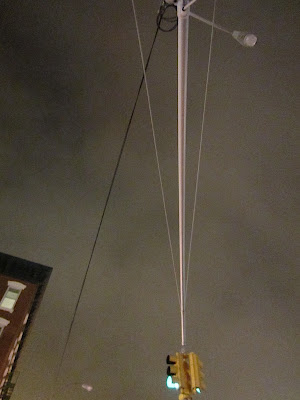I've been curious about some of the events of Oct. 29, when the East River was flooding Avenue C... and before the lights went out for the next 4-5 days. I'm trying to even
remember what happened that night. It seems like longer than 16 days ago. Maybe that's a good thing.
What I recall. About 6:30 that Monday night, with the storm on the way, I decided to take a walk around the neighborhood. Maybe get a drink. See what was going on. Take some pictures.
Great idea!
I stop by a few places. Not many people around. At this point, I'm just inside Vazac's. Before entering the second set of doors, I pause and quickly glance at my phone/email. There's an email from EVG reader faces from 7:01 p.m. saying that 14th Street and Avenue C was under water. He sent this photo:
It is now much later than 7:01. I leave and head east on Seventh Street... About a third of the way from Avenue C, I encounter the water rising on the street. I talk with a few people. No one is panicking. So far. I figure I can go back to Avenue B, and head south for a better vantage point. I'm right near that big Tompkins Square Plaza apartment complex at 190 E. Seventh St. when the sky to the southeast lights up in that greenish tint ... an explosion
from somewhere. I heard a variety of
WHOOOOAAAAAAAAs and
WOOOOOOOOOssss and
WTFs.
EVG regular William Klayer took this shot at
nearly the moment he heard the explosion about 8:13 p.m. or so:
Figure it
might be a good time to go home now. And you know the rest, after the second explosion...
Anyway, Stephen Gandel at
Fortune has published a detailed account of what happened at Con Ed the night of Superstorm Sandy... and how the utility eventually restored power to the city.... an excerpt...
By the time [Con Ed CEO James] Burke reached the command room, word was already circulating through the media and among his staff that Con Ed's 13th Street sub-station, one of the largest in the city, had blown up.
In the room, John Miksad, one of Burke's top lieutenants, was on the phone with a crew at one of the lower Manhattan power stations that had been turned off getting a report on the flooding when the lights in the command center went off and on. Miksad looked up at one of the three giant screens at the front of the room that displayed the number of Con Ed customers who had lost power. Before the lights went off it was about 100,000. When the screen came back on a moment later, the number had jumped by more than 200,000.
John McAvoy, another one of Burke's top lieutenants, was already on the phone with workers at the 13th Street station when Miksad came over. Everyone was okay. They didn't see any fires. Power was out. The first floor control room was still dry but outside the streets had turned into rivers. Water was pouring over the wall. They wanted out.
Miksad, though, wanted in. His computers weren't telling him anything. He would need to get into the plant and look at the equipment to know what had happened, but he couldn't leave the command center. He told McAvoy to send an engineer on the rescue mission.
Shortly after that, Miksad got an e-mail with a link to the now-infamous youtube clip of the 13th Street substation. That was the first time he saw the flash. Technically, the plant hadn't blown up. It was what they call an arc, kind of like the spark you sometimes get when you plug something into an outlet, except much more powerful. Arcs happen. But the flashes are only supposed to last fractions of a second before breakers divert the current away from the problem. The flash Miksad saw in the video went on for 30 seconds, and it seemed to come in waves. He watched the video again and again. "That's when I knew we had a problem," says Miksad. "And it was a very, very big one."
Read the whole article
here.


































